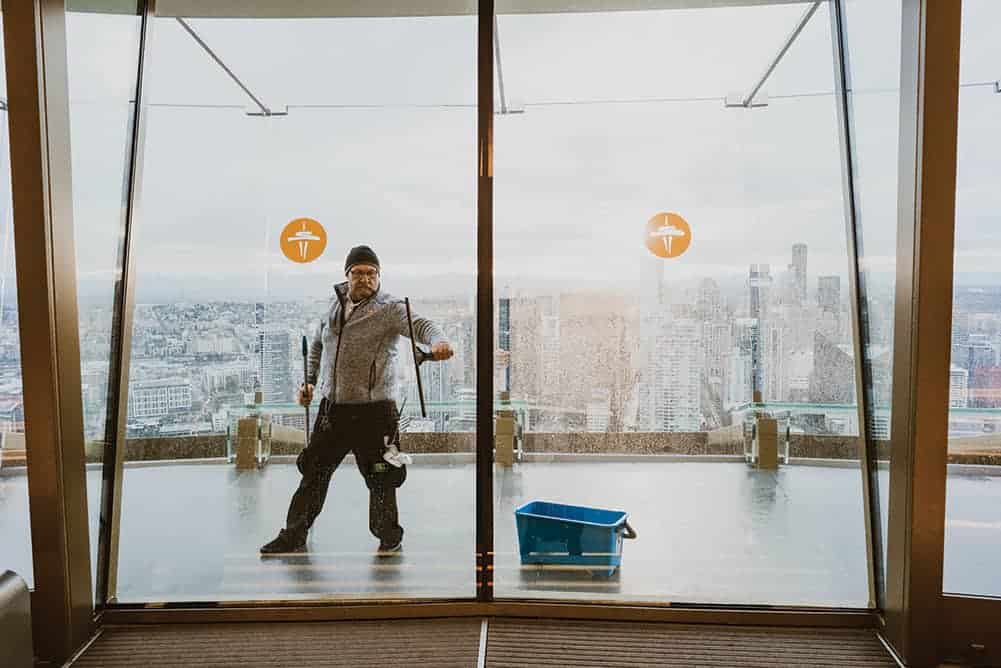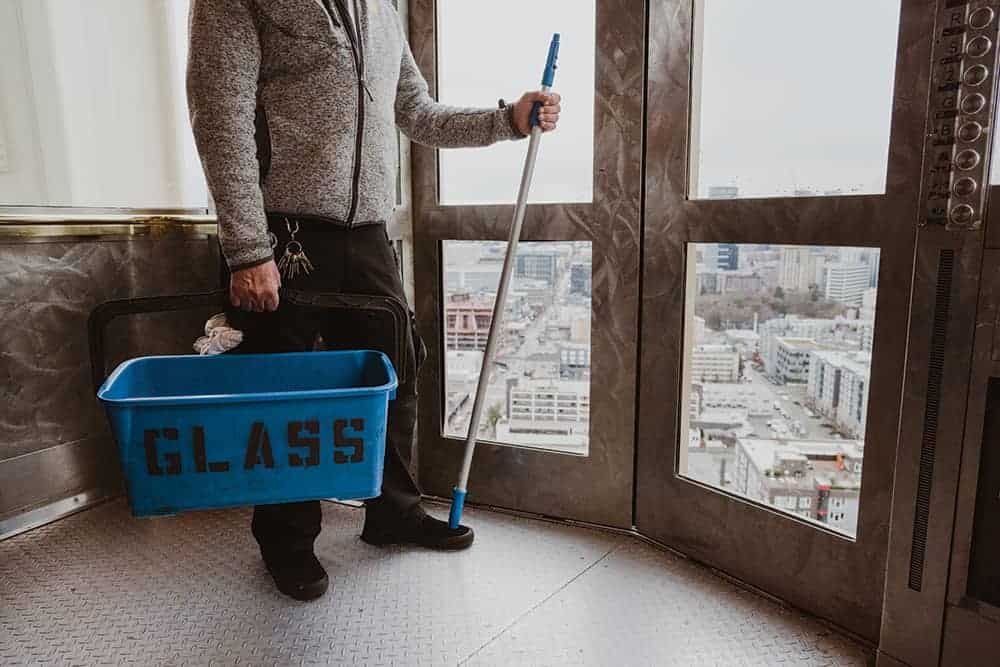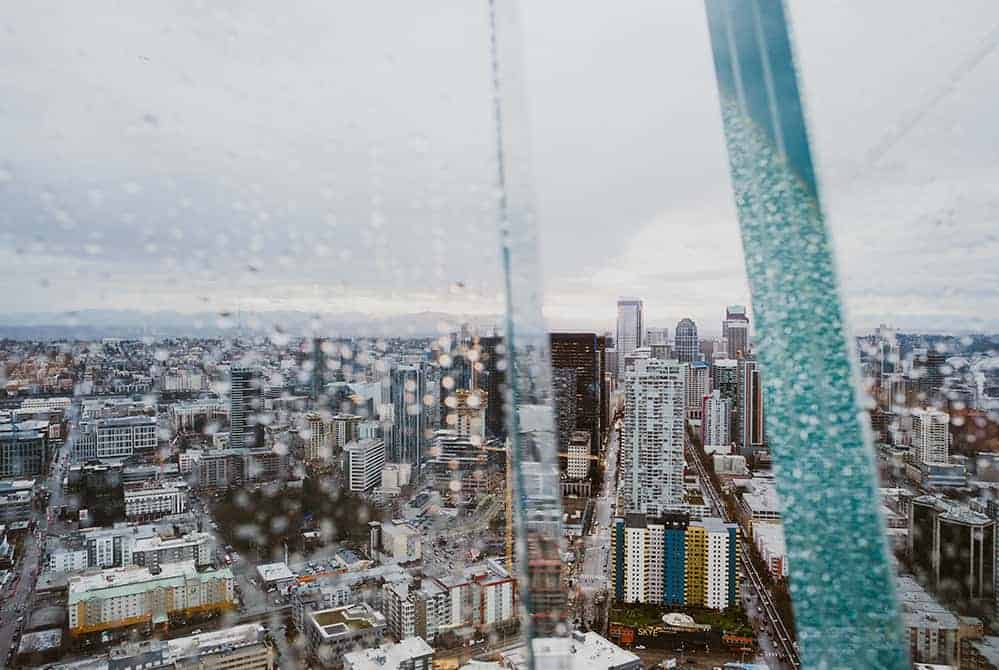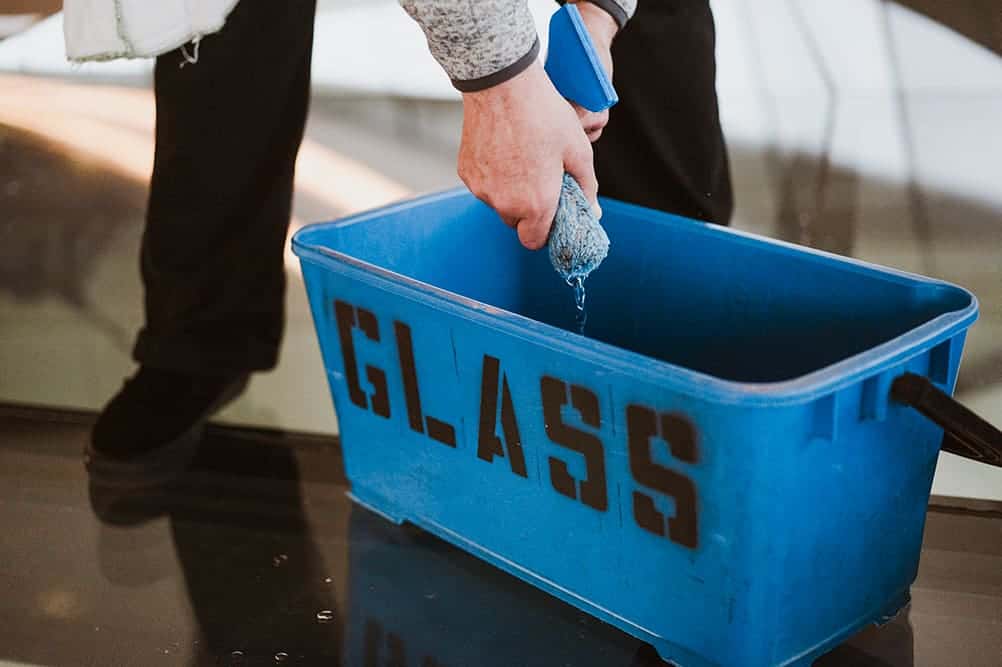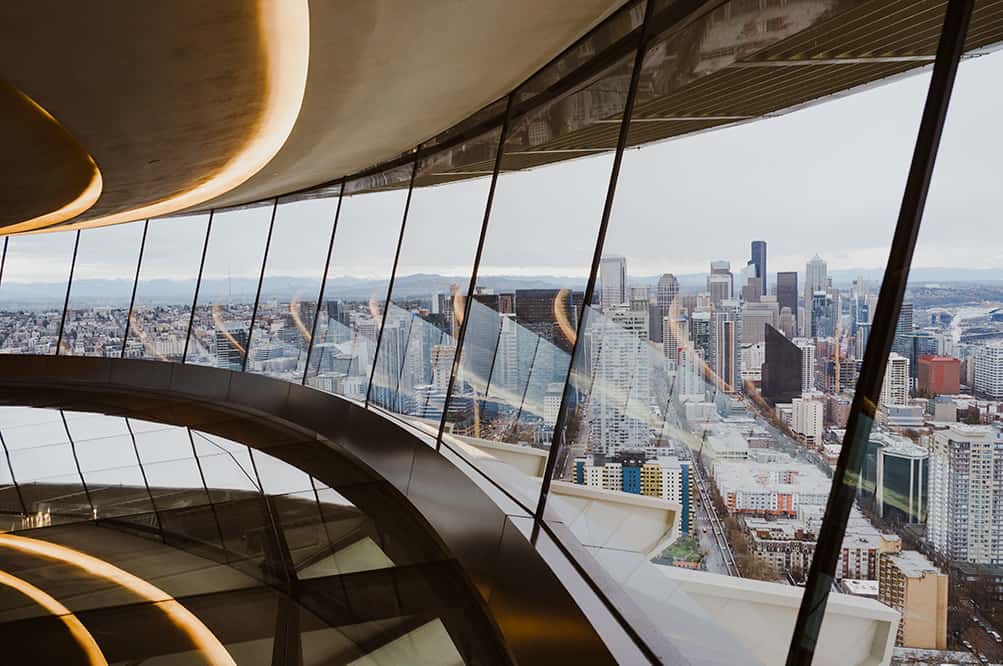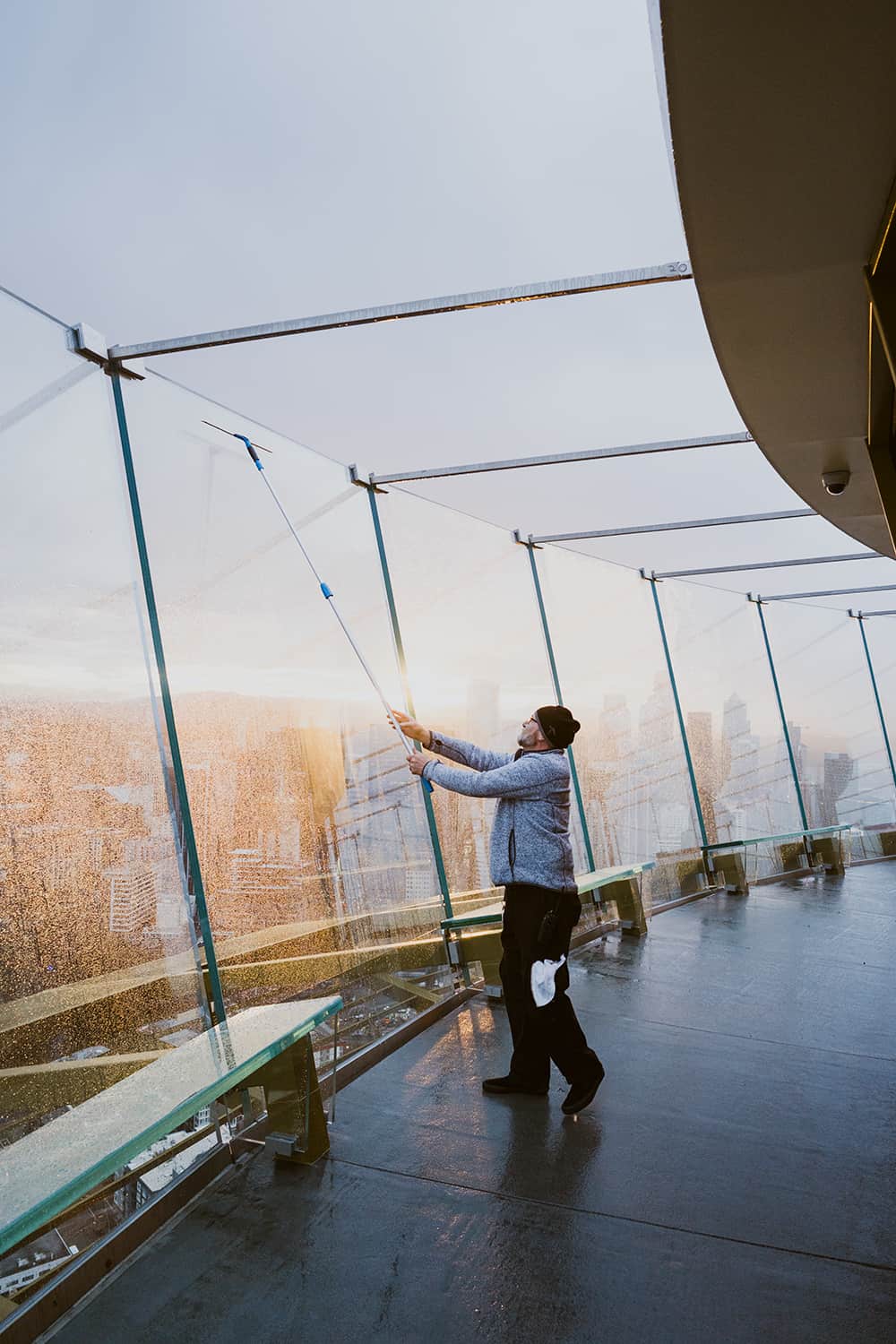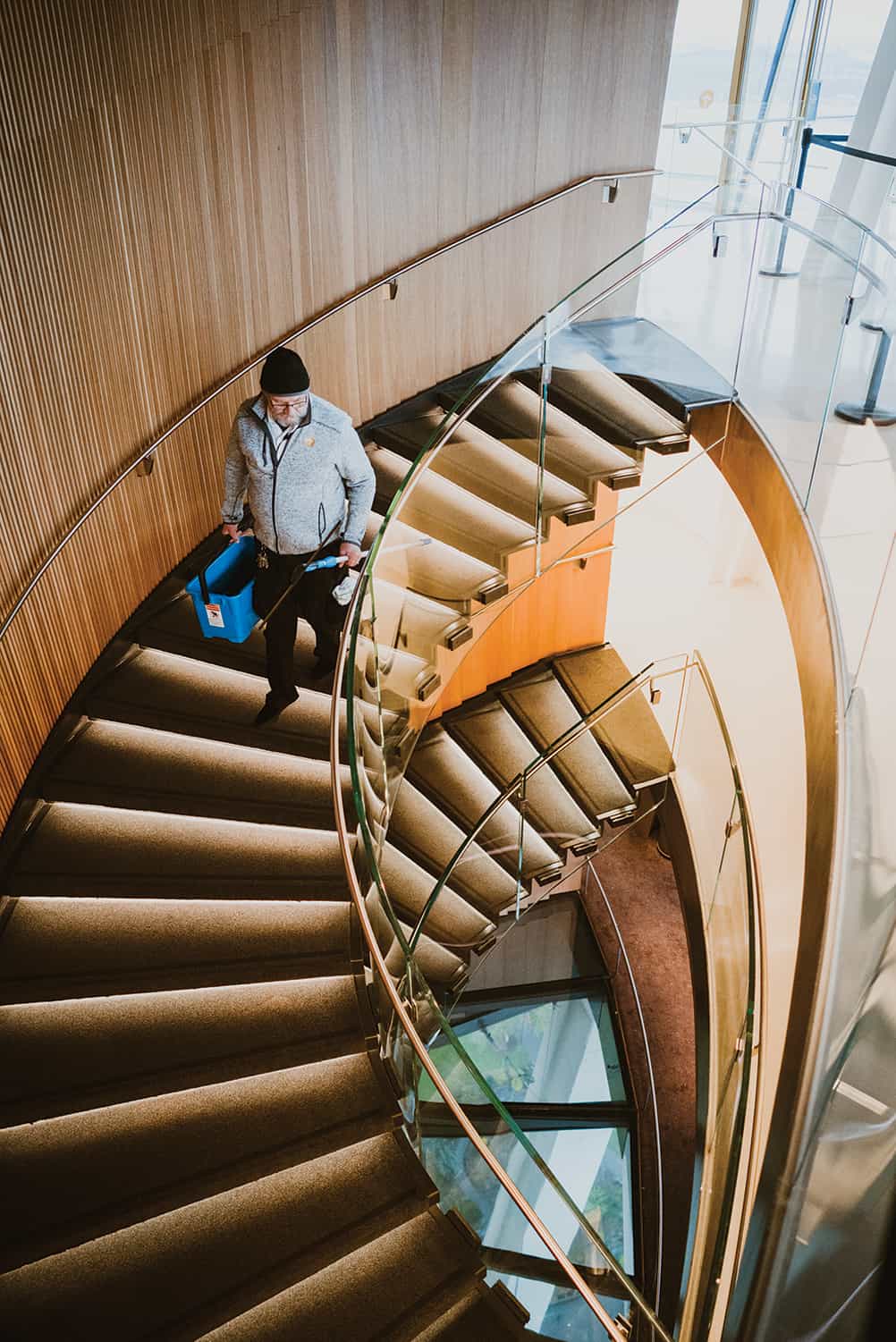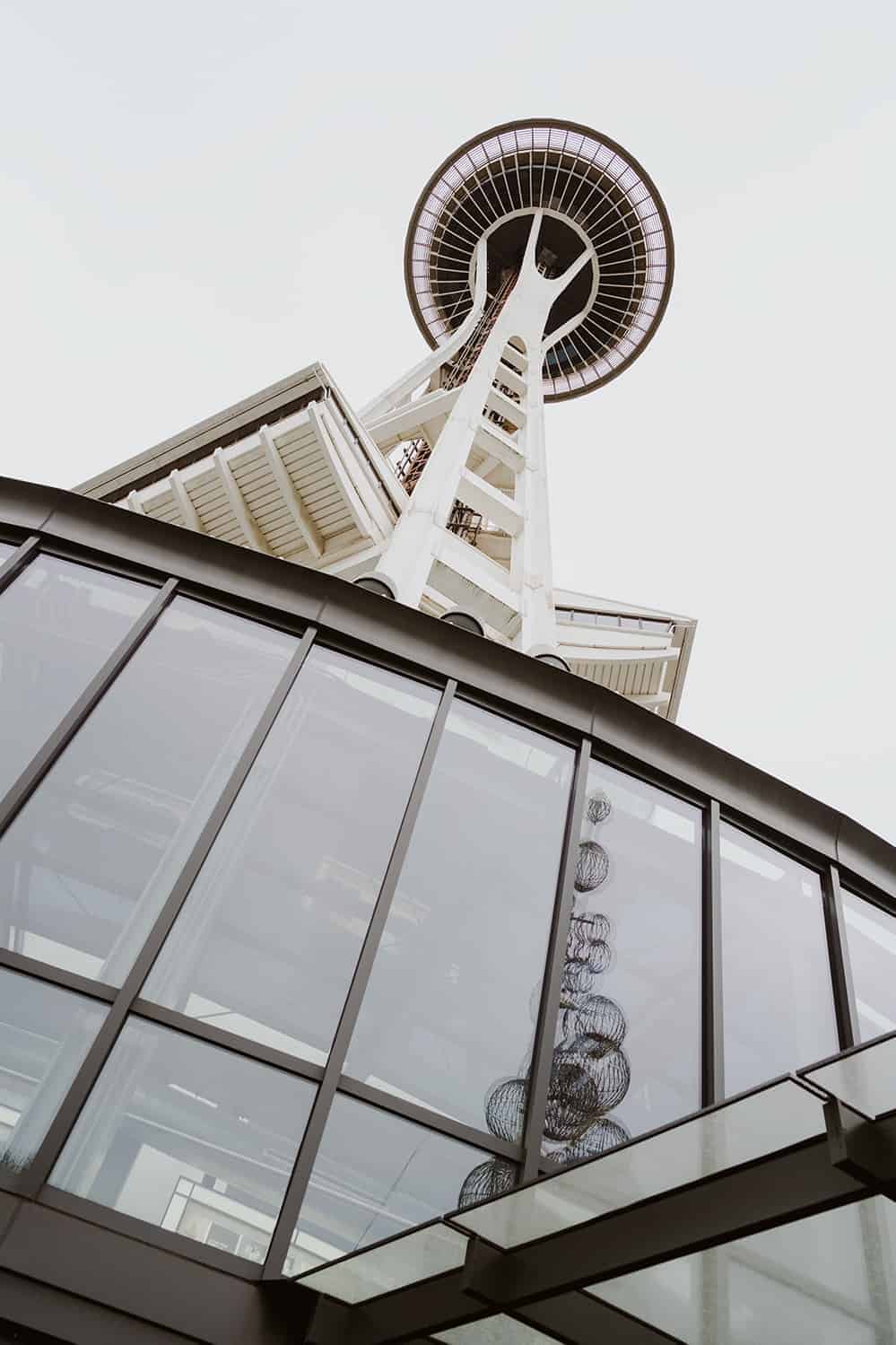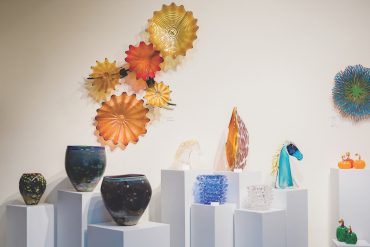Paul Best begins at 5:30 every morning with 20,000 square feet of glass in the newly renovated Space Needle
by Corinne Whiting | photography James Harnois
ON A BLUSTERY NOVEMBER MORNING, I joined Paul Best at the top of the 605-foot-tall Space Needle—undoubtedly Seattle’s most recognizable icon. I soaked in the 360-degree views, as surprise rays pierced through streaky clouds and illuminated the skyline.
Paul Best, head glass keeper since 2017, had already finished most of his morning duties but was happy to talk shop as the venue around us bustled. The doors had yet to open to the public, but we found ourselves in the midst of contractors tackling a punch list and worker bees setting up Santa’s glass sleigh, which would soon fill with eager youngsters. There was a faint aroma of sweetness (coffee? popcorn?) wafting through our sky-high perch. Holiday tunes added to the festive buzz.
Throughout our conversation, Best paused to point out smudges he’d caught sight of from across the room. … His eyes are trained to scour every inch of this place—his second home of sorts. Best seeks perfection for guests.
Best’s morning had begun hours earlier, when he arrived around 5:30 a.m.—his favorite part of the day. At this deserted hour, he happily pumps his music, grabs a coffee and watches the sun rise over Mount Rainier as it turns brilliant shades of pink, purple and orange. Or, on grayer days, he eases into things by watching clouds roll lazily across the city, rains descending onto neighboring Bellevue. Before long, he “gets in the groove” and begins cleaning the 176 tons and 20,000 square feet of glass under his care.
Throughout our conversation, Best paused to point out smudges he’d caught sight of from across the room. He also does this at stores and people’s homes, he admitted, but keeps those findings to himself. His eyes are trained to scour every inch of this place—his second home of sorts. Best seeks perfection for guests.
The Space Needle, which took approximately 400 days to build, officially opened to the public on April 21, 1962, for the Century 21 Exposition, a space age-themed world’s fair. And now, thanks to a “multi-year, multi-phase” $100 million “spacelift” renovation that began in September 2017, the visitor experience has been enhanced. The new-and-improved Needle helps realize the original vision of the tower’s designers, who were limited by building materials available to them at that time.
Among other highlights, the privately funded project elevates the observation deck experience with floor-to-ceiling glass on the interior and exterior, replacing wire safety “caging”. Most notably, the Needle is now home to the first-of-its-kind, rotating glass floor, on which guests can walk (or lie down) while taking in downward views of the structure’s base and colorful Seattle Center below. All in all, there’s been a 196 percent increase in the amount of glass installed at the Space Needle since renovations began, meaning Best and his team have their hands full. Truth be told, Best seems to like it this way.
“I am so in love with this entire remodel,” he said. “Every morning, I am still overwhelmed with what they were able to do.” One of his favorite parts of the job involves watching guests’ reactions as the elevator doors part, revealing initial glimpses out the windows.
When asked whether he minds the smudges left by folks leaning foreheads and fingers against the glass, Best joked, “We encourage it. … It’s job security. As long as I’m here, I’ll be busy and employed.” The biggest culprits? Lipstick from window “kisses,” imprints of kids’ gooey fingers and adults’ lotion-covered hands, plus hair product residue from those who’ve sprawled across the glass floor in optimal selfie-taking position.
Best’s team currently covers three separate shifts—two people work from about 5:30 a.m. until 2 p.m., one from 10 a.m. to 5 p.m. and two others from 2 p.m. until 10:30 p.m. “I’m extremely routine-oriented,” Best explained. The day begins by getting set up and doing a walk-through—assessing what’s been done the night before, and how well. Cleaners then get their kits together (a bucket, soap, pole, etc.). Plenty of research determined which products were the right ones, and they landed on an anti-glare option called Halo.
Best and an assistant start with the barrier walls circling the observation deck on upper Atmos, since these take the longest—between two and two-and-a-half hours to finish all forty-eight panes. They also need to get beneath the twenty-four new glass benches to keep those sparkling as well. “It gets a little manic at times,” Best said. “The entire goal is to get it shipshape before opening.”
So far, they’ve only used a Lalopod machine (named Frank) a couple times to clean the exterior of these barrier walls. The contraption, with a slim arm pole that reaches around to spray water and squeegee, takes only fifty seconds per section. However, it takes ten to fifteen minutes to move the machine between each of the deck’s forty-eight panes. The team also does window inspections every week or so, reporting back to a committee about any damage or scratches.
Cleaners then move down one level to The Loupe, tackling those 360 windows and the revolving 37-ton glass floor. The floor, made up of ten layers of glass provided by companies in Switzerland, Germany and California, rotates smoothly thanks to its twelve motors and forty-eight rollers. The window exteriors here also get sporadically cleaned by an engineer standing outside in a suspended basket as he pulls himself manually around the Needle’s perimeter.
On this level, the team only needs to clean the most visible part of the glass on a daily basis, though they reach the tip-top of the windows about once a month. “Smudge patrol” happens continuously, though, using a pole-less wiper covered in cloth diapers provided by next-door neighbor Chihuly Garden and Glass. Occasionally, the cleaners also have to head below the main floor, in between glass panes, and into the crawlspace below the new Oculus Stairs. They do this at night, when the uplighting helps with visibility.
The day we met, Best wore only a fleece to step outdoors. The week before, he had pulled out the white windbreaker provided by the venue. “Come rain or shine,” he said, “we’re out here.”
Best said the learning curve that accompanies working in a glass-covered space is still underway. Every day is an educational process for the next year, as the team discovers how the glass reacts to evolving weather patterns in every season. For example, employees constantly have to battle dew that reveals hidden imprints, as well as rain that’s “not pristine,” Best said. “I’ve become a little prissy about the glass.”
The job also brings a certain level of engagement, with visitors often asking Seattle-centric questions ranging from directions to citywide recommendations. “We’re glass keepers, but we’re also tour guides,” Best said. When hiring, this is a consideration he keeps in mind. He tells new employees, “If you’re not familiar with the city, get learning.”
Best loves chatting with patrons and welcomes their curiosity. However, there are a few questions he’s heard one too many times, like, “Will you come and clean my windows next?” Also: “Do you clean your own windows at home?” (Best’s favorite response: “No, I shut the blinds.”) He still chuckles about one frustrated guest who wanted to know why she couldn’t find the Space Needle when taking in the city’s panoramic views … from the Space Needle.
When Best got married last May, he took only three days off for his Tacoma wedding and Portland honeymoon, finding it a challenge to spend time away from his beloved venue. (There is talk of a proper getaway sometime next year.) “I totally love this place,” he said. “The entire feel has changed.”
Ironically, it seems being suspended this far above terra firma can give the best perspective. “If you’re starting to get stressed,” Best said, “you just come here to get grounded.”


